You can take the boy out of Colorado, but you can’t completely take the Colorado out of the boy. I did much of my growing up around the Rockies, and it wasn’t until I moved away to college that I realized just what a blessing it was to be able to stare at those impressive piles of rock. Years passed. Life happened – kids, moves, obligations – and I found myself longing to see the mountains again.
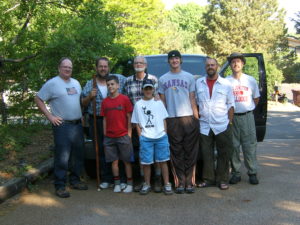
So, two times, an adventurous group of “flatlanders” from Joplin, MO made the drive to the middle of Colorado where we could pack in and soak up what the mountains had to offer. I had connections with some mountain trail-packing friends in Colorado who graciously helped us every step of the trip. For me, it provided a chance to take my boys on an adventure, do some mountain stream fishing, and possibly conquer a 14er or two (14er is a phrase we Grizzly Adams wannabes use for a mountain over 14,000’. Colorado has between 52 and 74 of them, depending on a number of criteria).
Our second trip was in 2008, a pack trip into what is called the Missouri Basin, near a collection of mountains named after colleges – the “Collegiate Peaks.” Around the 3rd day in, it was time for a few of us to tackle a mountain, possibly two. It was mid-June, early spring, as spring in the mountains goes. The air was cold, the streams were swollen and roaring with runoff, the flowers were just beginning to bud, and there was still some pretty heavy snow in the upper elevations. You have to start out early in the morning in order hike, summit, and get back down before the typical afternoon lightning storms. We arose, geared up, and started on the trail up Mt. Oxford from our base camp just as the sun was dawning.
When you live in high altitudes, it does something to your blood – literally. The red blood cell count increases as you spend time in thinner air, compensating for the lower oxygen levels that each breath provides for your body. That’s why people who attempt to summit Mt. Everest (elevation 29,029’) travel and live in stages for weeks at the increasing altitudes. It takes 3-6 weeks for your blood to adjust. “Timberline” is the very clear line across mountains where trees stop growing – about 12,000.’ Yes, trees don’t go any higher than that because they can no longer breathe! We had been at our basecamp at 11,000’ for 3 days. Not a lot of adjusting there for a group of guys from Missouri.
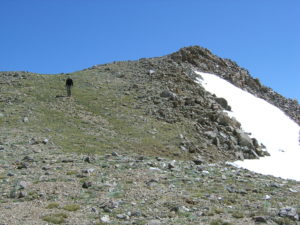
I chugged along with the other 4 guys (all younger than me) on this particular hike, pausing to take in the spectacular views and more than my share of the air. It took around 7 hours, but we finally reached the lonely, stony summit of Mt. Oxford, elev. 14,153’.
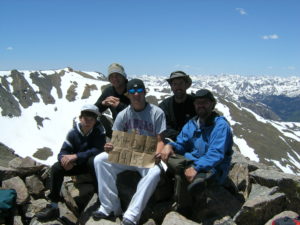
The air was very clear, and I could see over 100 miles away the backside of Pikes Peak, near where I used to live.
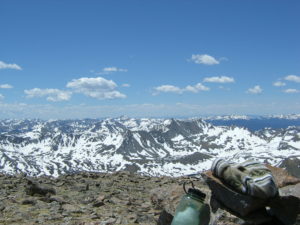
Amazing. This was my 2nd 14er, not a small thing to me. I gasped…because that’s what you do when you’re struggling to get O2 to your body! But, with Mt. Oxford, there’s a bonus. A little over a mile away is the peak of Mt. Belford. The two peaks are joined by a “saddle” requiring just a descent and a 2nd ascent, gaining 600’. People commonly hike up one mountain then up the other in the same trip. I could add another to my list in one day!
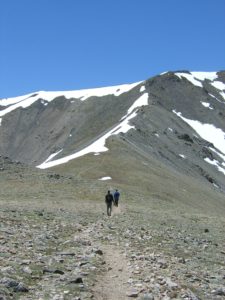
Tim and Doug, the 2 Colorado hiking devotees of our group, went on ahead. I had paused to “catch my breath” and ponder whether or not to attempt the 2nd mountain. I watched them as they walked on the trail, getting smaller and smaller in my view. Finally, I talked myself into making the hike. I headed down into the saddle, realizing that I’d have to climb back up on my return trip. Halfway across the saddle, I was ¼ of this trip done, then it started uphill again. Tim and Doug were out of sight now. Your mind does interesting calculations at this point, as your lungs, legs, and feet all chime in. I would walk for a minute, then stop and suck oxygen for a few minutes, walk for a minute, repeat. I made it about ½ way up the next ascent when eventually the view from the saddle began to look just as rewarding as the potential view from the summit, maybe even more so. I was losing heart. My strength had failed. Maybe one day in the future I would climb Mt. Belford. This was not that day. I rested a bit more and turned to head back up the previous peak. The mountain had beaten me.
There are life lessons to be learned on mountainsides. That day in June, I tapped into a couple. I was reminded that a difficult journey is greatly aided by being in the presence of others who are sharing the journey with you. I think that, if I had stuck with my traveling buddies, I may have summoned the strength to finish the ascent. We have been put on earth together for a purpose, and part of that purpose is to “spur one another on toward love and good deeds.” When the journey is challenging, that’s the best time to stay close to the others who are also on the trail with you.
Most of life isn’t spent on the mountaintop, and I’m glad it isn’t. It really isn’t a very accommodating place. In fact, nothing and no one stays there. It is, by necessity, a short visit, unless you’re really trying to be struck by lightning. Most of life is spent on the mountainside, and in the valley below. It’s good to occasionally go through the struggle to get to the top, marvel at the view, and regain some perspective, but that’s really not a long-term goal for life. Mountaintop experiences are mostly to help us live better lives in all the other places.
Human strength will sometimes fail me. I don’t think that it is in reference to literal mountain climbing, or literally sprouting wings, but words from God come to mind here…
Do you not know? Have you not heard?
The Everlasting God, the LORD, the Creator of the ends of the earth
Does not become weary or tired.
His understanding is inscrutable. He gives strength to the weary,
And to him who lacks might He increases power.
Though youths grow weary and tired,
And vigorous young men stumble badly,
Yet those who wait for the LORD
Will gain new strength;
They will mount up with wings like eagles,
They will run and not get tired,
They will walk and not become weary.
Isaiah 40:28-31
There are times in life when I am losing heart and human strength fails me. Some of these moments are optional climbs that I choose to take, but there are also times when failure simply is not an option. Even youths get tired and weary, and stumble badly. But those who wait for the LORD can expect to be helped by Him. The word for “wait” in the Old Testament doesn’t mean just sitting around and being patient. It means to have hopeful expectation; to eagerly watch for what God is going to do; to step back and say, “OK, Lord, this one’s in Your hands. What’s the way I’m going to make it up this thing?” and then watch for it. In day-to-day mountain climbs, that’s a wonderful help.
Try it. See if you gain new strength! See if you’re able to conquer the next mountain in front of you!
I don’t know if I’ll ever have the opportunity to summit another 14er in this life. It would be great to get to do that again. Maybe next summer… To this point of my life, I’m grateful for the lessons God has taught me and continues to teach me on the journey, in the valleys and on the peaks.
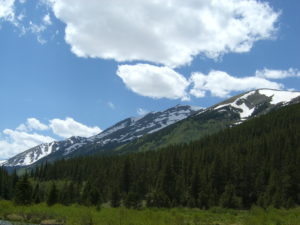
Let’s stick together on this trip, Traveling Buddy.
Sherm
